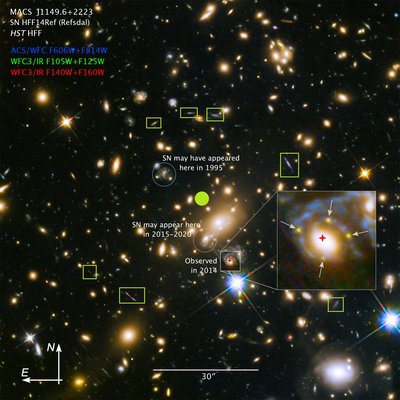by longtry » Tue Jul 16, 2019 4:12 am
@bystander: thanks for the links... Actually, there are so many links I got lost. But all (most?) of them are articles with the purpose of spreading news to the target audience of average Johns. I'd love a link where we can see in a model (preferably 3D) what the shape and size of that HC's dark matter is, and the position of the SN too. After all, if the scientist team who made the announcement can predict the time of SN's reappearance with so much accuracy, surely they must have built a full model and know where things are?
Chris Peterson wrote: ↑Mon Jul 15, 2019 1:08 pm
Specifically, the lensing mass has z=0.54 (~5 Gly), and the SN has z=1.49 (~9 Gly).
I have a feeling that in order for Einstein stuffs (ring, cross) to appear, the distance to the lense need to be around half the distance to the source, otherwise lights can't focus on Earth. If that's true, then maybe the farthest lense we can have is about 8Gly away?
neufer wrote: ↑Mon Jul 15, 2019 4:26 pm
With patience and [bad] luck, those two specific links have disappeared since "2015 Mar 09."
Sometimes latecomers like me get a bit jealous of early birds.
rstevenson wrote: ↑Mon Jul 15, 2019 12:51 pm
Given the four almost equally spaced images of the SN around the bright blob, I would guess that the SN is directly behind it -- perhaps a little off center. But those in the know can likely calculate this instead of guess, and I'm just an interested amateur. For example, the center of mass of the entire cluster would also have an influence on the path the SN's light took getting to and around that blob.
Thanks again, Bob

That's my guess too. It'd be much better if those guys in the know release more details of their research.
Since no one has commented on the previous pic, I suppose that everyone is OK with my assumption. Now with Bob's confirmation about the SN, I've modified the image once again, this time adding 2 red marks indicating the SN, 9Gly from Earth,
in the position it would be in if there were no HC+IS at all. OK, time for 2nd question:
2. How could another ghost image of the SN "may" appear in the blue circle in 1995?? Light had to bend all the way around and thus needed to travel way way farther than through the nearly straight IS route. It'd be more like 2035 with the configuration we're talking about.
- Attachments
-

- New addition is the red "star" depicting the SN true place.
@bystander: thanks for the links... Actually, there are so many links I got lost. But all (most?) of them are articles with the purpose of spreading news to the target audience of average Johns. I'd love a link where we can see in a model (preferably 3D) what the shape and size of that HC's dark matter is, and the position of the SN too. After all, if the scientist team who made the announcement can predict the time of SN's reappearance with so much accuracy, surely they must have built a full model and know where things are?
[quote="Chris Peterson" post_id=293734 time=1563196121 user_id=117706]
Specifically, the lensing mass has z=0.54 (~5 Gly), and the SN has z=1.49 (~9 Gly).
[/quote]I have a feeling that in order for Einstein stuffs (ring, cross) to appear, the distance to the lense need to be around half the distance to the source, otherwise lights can't focus on Earth. If that's true, then maybe the farthest lense we can have is about 8Gly away?
[quote=neufer post_id=293743 time=1563208015 user_id=124483]
With patience and [bad] luck, those two specific links have disappeared since "2015 Mar 09."[/quote]Sometimes latecomers like me get a bit jealous of early birds.
[quote=rstevenson post_id=293733 time=1563195084 user_id=124801]
Given the four almost equally spaced images of the SN around the bright blob, I would guess that the SN is directly behind it -- perhaps a little off center. But those in the know can likely calculate this instead of guess, and I'm just an interested amateur. For example, the center of mass of the entire cluster would also have an influence on the path the SN's light took getting to and around that blob.[/quote]Thanks again, Bob :) That's my guess too. It'd be much better if those guys in the know release more details of their research.
Since no one has commented on the previous pic, I suppose that everyone is OK with my assumption. Now with Bob's confirmation about the SN, I've modified the image once again, this time adding 2 red marks indicating the SN, 9Gly from Earth, [b]in the position it would be in if there were no HC+IS at all[/b]. OK, time for 2nd question:
2. How could another ghost image of the SN "may" appear in the blue circle in 1995?? Light had to bend all the way around and thus needed to travel way way farther than through the nearly straight IS route. It'd be more like 2035 with the configuration we're talking about.